Themed collection 2020 ChemSci Pick of the Week Collection

Tandem diaza-Cope rearrangement polymerization: turning intramolecular reaction into powerful polymerization to give enantiopure materials for Zn2+ sensors
Herein, we report a new tandem diaza-Cope rearrangement polymerization synthesizing enantiopure polymers with defect-free C–C bond formation. Furthermore, these polymers can be applied as high-performance turn-on Zn2+ sensors.
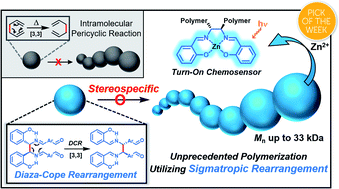
Chem. Sci., 2021,12, 2404-2409
https://doi.org/10.1039/D0SC06138G
Reversible carbon–boron bond formation at platinum centers through σ-BH complexes
A reversible carbon–boron bond formation has been observed in the reaction of the coordinatively unsaturated, cyclometalated, Pt(II) complex [Pt(ItBuiPr′)(ItBuiPr)][BArF], 1, with tricoordinated boranes HBR2.
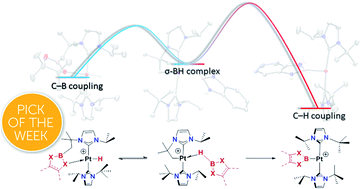
Chem. Sci., 2021,12, 1647-1655
https://doi.org/10.1039/D0SC05522K
Light-fueled dynamic covalent crosslinking of single polymer chains in non-equilibrium states
Synthetic polymers consume green light as fuel for intramolecular crosslinking, yielding non-equilibrium single chain nanoparticles that can be light-stabilised, kinetically and chemically trapped, or else unfold in the absence of light fuel.

Chem. Sci., 2021,12, 1302-1310
https://doi.org/10.1039/D0SC05818A
Total synthesis and complete configurational assignment of amphirionin-2
An extensive application of cobalt-catalyzed Mukaiyama-type cyclization of γ-hydroxy olefins and a late-stage Stille-type reaction enabled syntheses of four diastereomers of amphirionin-2 to establish its absolute configuration.
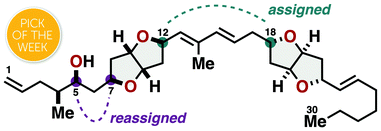
Chem. Sci., 2021,12, 872-879
https://doi.org/10.1039/D0SC06021F
On Raman optical activity sign-switching between the ground and excited states leading to an unusual resonance ROA induced chirality
Unusual solute to solvent induced chirality in ROA comes from specific conformer equilibria in the ground and the excited states.
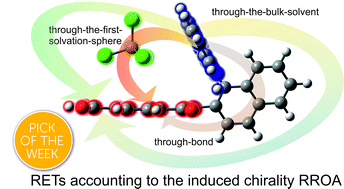
Chem. Sci., 2021,12, 911-916
https://doi.org/10.1039/D0SC05345G
Cooperative activating effects of metal ion and Brønsted acid on a metal oxo species
Combining a weak Lewis acid and weak Brønsted acid produces strong cooperative effects for activating metal oxo species towards alkane oxidation.
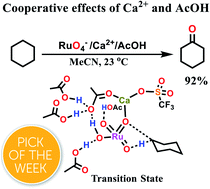
Chem. Sci., 2021,12, 632-638
https://doi.org/10.1039/D0SC04069J
Fucosylated ubiquitin and orthogonally glycosylated mutant A28C: conceptually new ligands for Burkholderia ambifaria lectin (BambL)
Metal free click reactions used to glycosylate ubiquitin and its mutant A28C afforded two protein scaffolds with high affinity for Burkholderia ambifaria lectin (BambL).
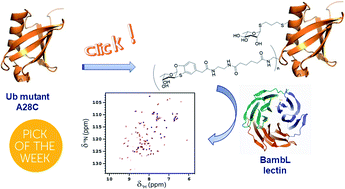
Chem. Sci., 2020,11, 12662-12670
https://doi.org/10.1039/D0SC03741A
Hyperpositive non-linear effects: enantiodivergence and modelling
An asymmetric reaction consisting of competing monomeric and dimeric catalysts may explain enantiodivergent non-linear effects.
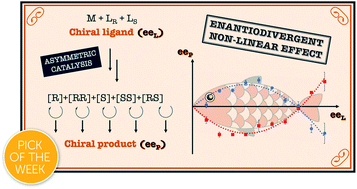
Chem. Sci., 2020,11, 12453-12463
https://doi.org/10.1039/D0SC04724D
Unveiling the molecular mechanism of SARS-CoV-2 main protease inhibition from 137 crystal structures using algebraic topology and deep learning
By integrating algebraic topology and deep learning, we provide a reliable ranking of binding affinities, binding site analysis, and fragment decomposition for 137 SARS-CoV-2 main protease inhibitors.
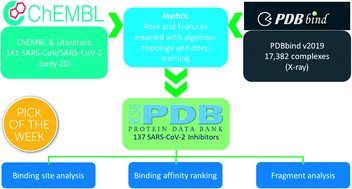
Chem. Sci., 2020,11, 12036-12046
https://doi.org/10.1039/D0SC04641H
Data-powered augmented volcano plots for homogeneous catalysis
Augmented volcano plots, a tool for comparing and visualizing the similarity of a number of complete catalytic cycle energy profiles to that of an ideal reference profile without relying on linear scaling relationships, are introduced.
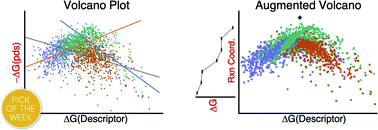
Chem. Sci., 2020,11, 12070-12080
https://doi.org/10.1039/D0SC04289G
Covalent cucurbit[7]uril–dye conjugates for sensing in aqueous saline media and biofluids
Unimolecular chemosensor shows superior stability and detection capabilities in biofluids compared to bimolecular reporter pairs.
![Graphical abstract: Covalent cucurbit[7]uril–dye conjugates for sensing in aqueous saline media and biofluids](/en/Image/Get?imageInfo.ImageType=GA&imageInfo.ImageIdentifier.ManuscriptID=D0SC03079A&imageInfo.ImageIdentifier.Year=2020)
Chem. Sci., 2020,11, 11142-11153
https://doi.org/10.1039/D0SC03079A
Total synthesis of dimeric Securinega alkaloids (−)-flueggenines D and I
The first total synthesis of dimeric securinega alkaloids (−)-flueggenines D and I was completed by a dimerization strategy that involves Stille reaction and stereoselective conjugate reduction.
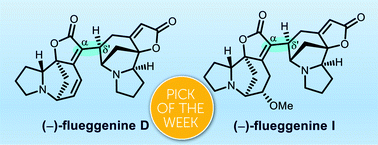
Chem. Sci., 2020,11, 10934-10938
https://doi.org/10.1039/D0SC03057K
Glycan–glycan interactions determine Leishmania attachment to the midgut of permissive sand fly vectors
Force spectroscopy was used to measure the adhesion of Leishmania to synthetic mimics of galectins on the sand fly midgut.
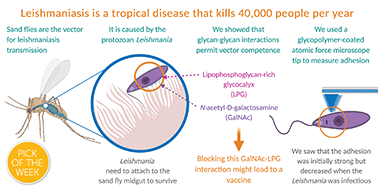
Chem. Sci., 2020,11, 10973-10983
https://doi.org/10.1039/D0SC03298K
Modulating magnetic anisotropy in Ln(III) single-ion magnets using an external electric field
Using a combination of theoretical tools, we show that the application of an external electric field in a certain direction can boost the axiality beyond that set by the ligands, opening up a new avenue for the generation of novel SIMs.
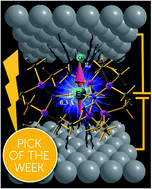
Chem. Sci., 2020,11, 10324-10330
https://doi.org/10.1039/D0SC03982A
A heterometallic [LnLn′Ln] lanthanide complex as a qubit with embedded quantum error correction
We show that a [Er–Ce–Er] molecular trinuclear coordination compound is a promising platform to implement the three-qubit quantum error correction code protecting against pure dephasing, the most important error in magnetic molecules.
![Graphical abstract: A heterometallic [LnLn′Ln] lanthanide complex as a qubit with embedded quantum error correction](/en/Image/Get?imageInfo.ImageType=GA&imageInfo.ImageIdentifier.ManuscriptID=D0SC03107K&imageInfo.ImageIdentifier.Year=2020)
Chem. Sci., 2020,11, 10337-10343
https://doi.org/10.1039/D0SC03107K
Surface hydration for antifouling and bio-adhesion
Antifouling properties of materials play crucial roles in many important applications such as biomedical implants, marine antifouling coatings, biosensing, and membranes for separation.
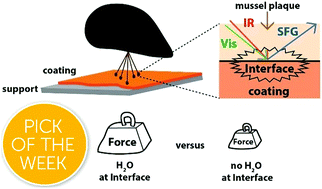
Chem. Sci., 2020,11, 10367-10377
https://doi.org/10.1039/D0SC03690K
Breaking the barrier: an osmium photosensitizer with unprecedented hypoxic phototoxicity for real world photodynamic therapy
A nontoxic Os(II) oligothienyl complex Os-4T is an extremely potent light-responsive anticancer agent that can be activated in hypoxia and with NIR light.
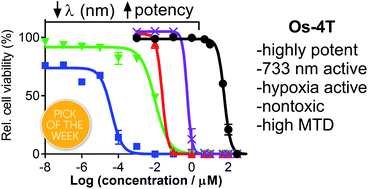
Chem. Sci., 2020,11, 9784-9806
https://doi.org/10.1039/D0SC03008B
Increasing protein stability by engineering the n → π* interaction at the β-turn
Amino acid residues adopt a right-handed α-helical conformation with increasing strength of the n → π* interaction. We also demonstrate a direct consequence of n → π* interactions on enhancing the structural stability of proteins.

Chem. Sci., 2020,11, 9480-9487
https://doi.org/10.1039/D0SC03060K
In situ tissue pathology from spatially encoded mass spectrometry classifiers visualized in real time through augmented reality
Integration between a hand-held mass spectrometry desorption probe based on picosecond infrared laser technology (PIRL-MS) and an optical surgical tracking system demonstrates in situ tissue pathology from point-sampled mass spectrometry data.

Chem. Sci., 2020,11, 8723-8735
https://doi.org/10.1039/D0SC02241A
Rapid formation and real-time observation of micron-sized conjugated nanofibers with tunable lengths and widths in 20 minutes by living crystallization-driven self-assembly
New fully conjugated block copolymers formed semiconducting 1D nanofibers with excellent structural and size control. The rapid living CDSA enabled us to watch the real-time video of the whole self-assembly process.

Chem. Sci., 2020,11, 8416-8424
https://doi.org/10.1039/D0SC02891F
Driving high quantum yield NIR emission through proquinoidal linkage motifs in conjugated supermolecular arrays
Incorporation of proquinoidal BTD building blocks into conjugated porphyrin oligomers minimizes the extent of excited-state structural relaxation relative to the ground-state conformation, elucidating new classes of impressive NIR fluorophores.
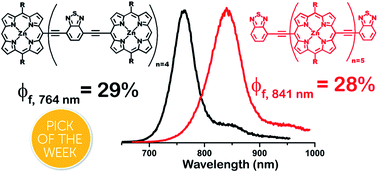
Chem. Sci., 2020,11, 8095-8104
https://doi.org/10.1039/D0SC03446K
Detection of magnetic field effects by confocal microscopy
Confocal microscopy is showcased as a powerful technique for the measurement of spatiotemporally-resolved magnetic field effects in both solutions and single crystals.
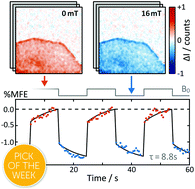
Chem. Sci., 2020,11, 7772-7781
https://doi.org/10.1039/D0SC01986K
Radical condensation between benzylic alcohols and acetamides to form 3-arylpropanamides
Benzylic alcohols and acetamides are coupled into 3-arylpropanamides by a new radical condensation through the radical anion of the alcohol.
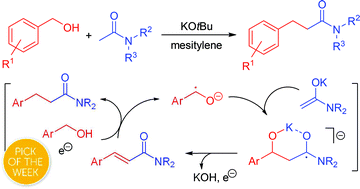
Chem. Sci., 2020,11, 7800-7806
https://doi.org/10.1039/D0SC02948C
Simple, scalable mechanosynthesis of metal–organic frameworks using liquid-assisted resonant acoustic mixing (LA-RAM)
We present a rapid and readily scalable methodology for the mechanosynthesis of diverse metal–organic frameworks (MOFs) in the absence of milling media typically required for other types of mechanochemical syntheses.

Chem. Sci., 2020,11, 7578-7584
https://doi.org/10.1039/D0SC00333F
Comprehending the quadruple bonding conundrum in C2 from excited state potential energy curves
The question of quadruple bonding in C2 has emerged as a hot button issue, with opinions sharply divided between the practitioners of Valence Bond (VB) and Molecular Orbital (MO) theory.
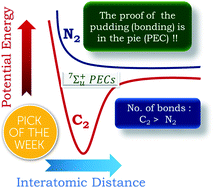
Chem. Sci., 2020,11, 7009-7014
https://doi.org/10.1039/D0SC02336A
Computer-generated “synthetic contingency” plans at times of logistics and supply problems: scenarios for hydroxychloroquine and remdesivir
A computer program for retrosynthetic planning helps develop multiple “synthetic contingency” plans for hydroxychloroquine and also routes leading to remdesivir, both promising but yet unproven medications against COVID-19.
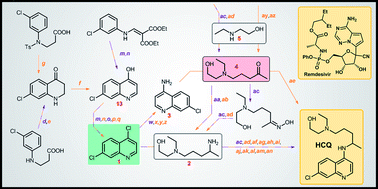
Chem. Sci., 2020,11, 6736-6744
https://doi.org/10.1039/D0SC01799J
Real-time tracking of the entangled pathways in the multichannel photodissociation of acetaldehyde
Unraveling the entangled multi-channel dissociation pathways by a two-dimensional, time and product pair-correlation, measurement and ab initio calculations.
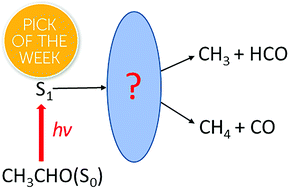
Chem. Sci., 2020,11, 6423-6430
https://doi.org/10.1039/D0SC00063A
The effect of structural heterogeneity upon the microviscosity of ionic liquids
The behaviour of two molecular rotors have been studied in various ionic liquids. Time resolved fluorescence shows a complex relationship between the bulk viscosity of the ionic liquid and microstructure of solvent around each molecular rotor.
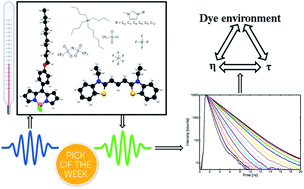
Chem. Sci., 2020,11, 6121-6133
https://doi.org/10.1039/D0SC02009E
Enhancing a de novo enzyme activity by computationally-focused ultra-low-throughput screening
De novo enzymes capable of efficiently catalysis of a non-natural reaction are obtained through minimalist design plus computationally-focused variant library screening.
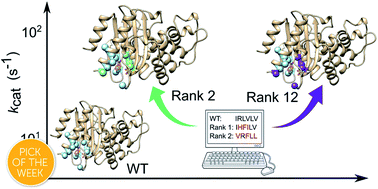
Chem. Sci., 2020,11, 6134-6148
https://doi.org/10.1039/D0SC01935F
The role of porphyrin peripheral substituents in determining the reactivities of ferrous nitrosyl species
Ferrous nitrosyl {FeNO}7 species is an intermediate common to the catalytic cycles of Cd1NiR and CcNiR, two heme-based nitrite reductases (NiR), and its reactivity varies dramatically in these enzymes.
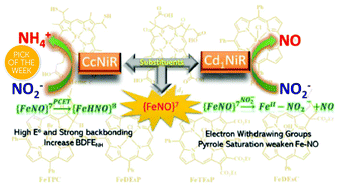
Chem. Sci., 2020,11, 5909-5921
https://doi.org/10.1039/D0SC01625J
Spontaneous mirror symmetry breaking in benzil-based soft crystalline, cubic liquid crystalline and isotropic liquid phases
Achiral multi-chain benzil derivatives provide a missing link between mirror symmetry breaking phenomena in fluid systems of polycatenar and bent-core liquid crystals.
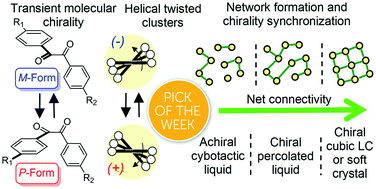
Chem. Sci., 2020,11, 5902-5908
https://doi.org/10.1039/D0SC01396J
Quinone methide dimers lacking labile hydrogen atoms are surprisingly excellent radical-trapping antioxidants
Quinone method dimers, (bio)synthetic intermediates en route to many naturally products derived from resveratrol, are potent radical-trapping antioxidants, besting the phenols from which they are derived and to which they can be converted.
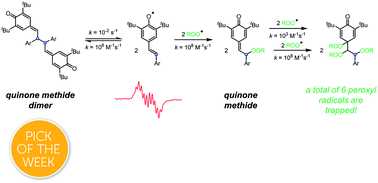
Chem. Sci., 2020,11, 5676-5689
https://doi.org/10.1039/D0SC02020F
Coordination polymer glass from a protic ionic liquid: proton conductivity and mechanical properties as an electrolyte
A proton-conducting coordination polymer glass derived from a protic ionic liquid works as a moldable solid electrolyte and the anhydrous fuel cell showed I–V performance of 0.15 W cm−2 at 120 °C.
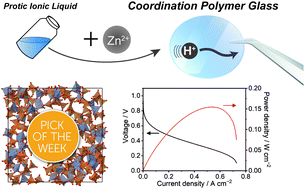
Chem. Sci., 2020,11, 5175-5181
https://doi.org/10.1039/D0SC01737J
Sequential C–O decarboxylative vinylation/C–H arylation of cyclic oxalates via a nickel-catalyzed multicomponent radical cascade
A selective, sequential C–O decarboxylative vinylation/C–H arylation of cyclic alcohol derivatives enabled by visible-light photoredox/nickel dual catalysis has been described.
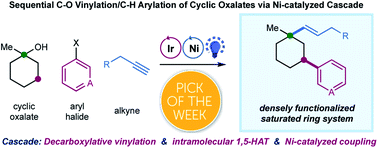
Chem. Sci., 2020,11, 4904-4910
https://doi.org/10.1039/D0SC01471K
Engineering bio-mimicking functional vesicles with multiple compartments for quantifying molecular transport
Giant vesicle functional models mimicking a bacterial membrane under physiological conditions are constructed.
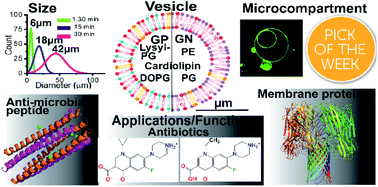
Chem. Sci., 2020,11, 4669-4679
https://doi.org/10.1039/D0SC00084A
Spectral deep learning for prediction and prospective validation of functional groups
A new multi-label deep neural network architecture is used to combine Infrared and mass spectra, trained on single compounds to predict functional groups, and experimentally validated on complex mixtures.

Chem. Sci., 2020,11, 4618-4630
https://doi.org/10.1039/C9SC06240H
Peculiar bond characters of fivefold coordinated octet compound crystals
A refreshed view of chemical bonds in solids unveils unusual bonding in fivefold coordinated bulk crystals of octet compounds: out-of-plane cation–anion chain bonding via overlapping pz orbitals replaces in-plane π bonding of the isolated monolayer.
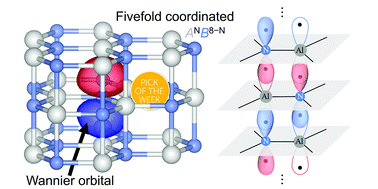
Chem. Sci., 2020,11, 4340-4350
https://doi.org/10.1039/D0SC00292E
Trends in C–O and N–O bond scission on rutile oxides described using oxygen vacancy formation energies
Oxygen vacancy formation energy is a simple and accurate descriptor for C–O and N–O bond scissions on 3d-rutile oxides.
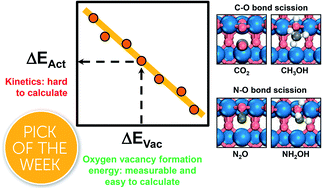
Chem. Sci., 2020,11, 4119-4124
https://doi.org/10.1039/D0SC00534G
A highly X-ray sensitive iridium prodrug for visualized tumor radiochemotherapy
A highly X-ray sensitive molecular prodrug, Ir-NB, was reported for visualized tumor radiochemotherapy. To our knowledge, the sensitivity enhancement ratio of the prodrug is the highest among the reported radiotherapy metal complexes drugs.
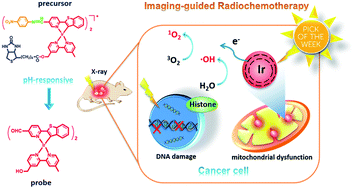
Chem. Sci., 2020,11, 3780-3789
https://doi.org/10.1039/D0SC00862A
The redox-coupled proton-channel opening in cytochrome c oxidase
The interplay of cytochrome c oxidase's cofactor electrostatics, long-range conformational changes, H-bond rearrangement, and water dynamics enables transient proton-channel activation.
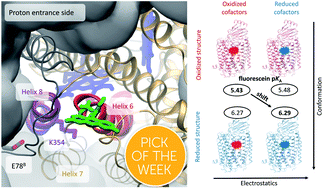
Chem. Sci., 2020,11, 3804-3811
https://doi.org/10.1039/C9SC06463J
Probing the electronic and mechanistic roles of the μ4-sulfur atom in a synthetic CuZ model system
Experimental data and computational modeling indicates an active role for the bridging sulfide ligand in a synthetic CuZ model.
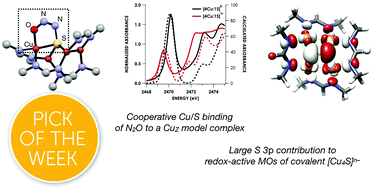
Chem. Sci., 2020,11, 3441-3447
https://doi.org/10.1039/C9SC06251C
Dye-sensitized solar cells under ambient light powering machine learning: towards autonomous smart sensors for the internet of things
Indoor light harvesters enable machine learning on fully autonomous IoT devices at 2.72 × 1015 photons per inference.
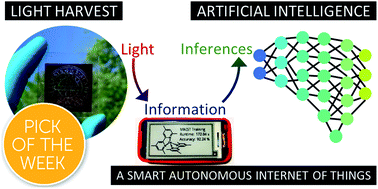
Chem. Sci., 2020,11, 2895-2906
https://doi.org/10.1039/C9SC06145B
High-yield gram-scale organic synthesis using accelerated microdroplet/thin film reactions with solvent recycling
A closed system has been designed to perform microdroplet/thin film reactions with solvent recycling capabilities for gram-scale chemical synthesis.
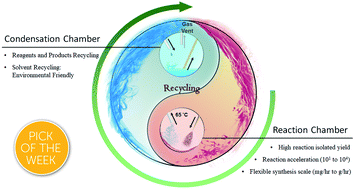
Chem. Sci., 2020,11, 2356-2361
https://doi.org/10.1039/C9SC06265C
Solar water splitting over Rh0.5Cr1.5O3-loaded AgTaO3 of a valence-band-controlled metal oxide photocatalyst
One-step photoexcitation type solar water splitting with a valence-band-controlled metal oxide photocatalyst.
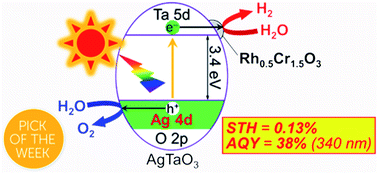
Chem. Sci., 2020,11, 2330-2334
https://doi.org/10.1039/C9SC05909A
Supramolecular and biomacromolecular enhancement of metal-free magnetic resonance imaging contrast agents
Supramolecular/macromolecular organic radical contrast agents (smORCAs) overcome many of the limitations of nitroxide radicals for use in magnetic resonance imaging in vivo like poor stability and weak contrast.
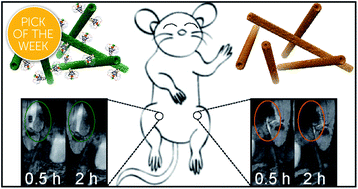
Chem. Sci., 2020,11, 2045-2050
https://doi.org/10.1039/C9SC05510J
Mechanisms of IR amplification in radical cation polarons
Break down of the Born–Oppenheimer approximation is caused by mixing of electronic and vibrational transitions in the radical cations of some conjugated polymers, resulting in unusually intense vibrational bands known as infrared active vibrations (IRAVs).
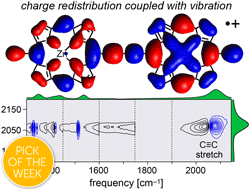
Chem. Sci., 2020,11, 2112-2120
https://doi.org/10.1039/C9SC05717J
A shape changing tandem Rh(CNC) catalyst: preparation of bicyclo[4.2.0]octa-1,5,7-trienes from terminal aryl alkynes
Two catalysts for the price of one: a shape changing rhodium catalyst enables preparation of unusual isobenzenes using a one-pot procedure.
![Graphical abstract: A shape changing tandem Rh(CNC) catalyst: preparation of bicyclo[4.2.0]octa-1,5,7-trienes from terminal aryl alkynes](/en/Image/Get?imageInfo.ImageType=GA&imageInfo.ImageIdentifier.ManuscriptID=C9SC06153C&imageInfo.ImageIdentifier.Year=2020)
Chem. Sci., 2020,11, 2051-2057
https://doi.org/10.1039/C9SC06153C
Design of high-temperature f-block molecular nanomagnets through the control of vibration-induced spin relaxation
An efficient general first-principles methodology to simulate vibration-induced spin relaxation in f-block molecular nanomagnets that drastically reduces the computation time.

Chem. Sci., 2020,11, 1593-1598
https://doi.org/10.1039/C9SC03133B
Ultrafast spectral hole burning reveals the distinct chromophores in eumelanin and their common photoresponse
Seeing the colors in black: ultrafast transient hole burning spectroscopy reveals the absorption properties of discrete chromophores and their interactions in the skin pigment eumelanin.
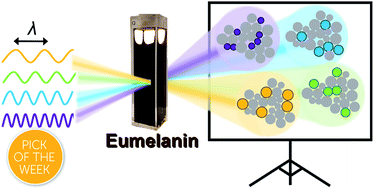
Chem. Sci., 2020,11, 1248-1259
https://doi.org/10.1039/C9SC04527A
Expanding medicinal chemistry into 3D space: metallofragments as 3D scaffolds for fragment-based drug discovery
Fragment-based drug discovery (FBDD) using 3-dimensional metallofragments is a new strategy for the identification of bioactive molecules.
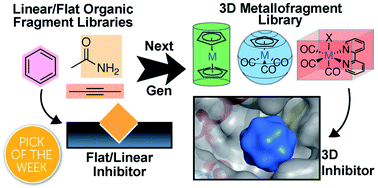
Chem. Sci., 2020,11, 1216-1225
https://doi.org/10.1039/C9SC05586J
About this collection
In 2018, the Chemical Science Editorial Team launched ‘ChemSci Pick of the Week’ as a means to select and promote our favourite articles from the week and share them with the wider chemical community. This on-going web collection showcases all ChemSci Picks from 2020.
All ChemSci Picks are promoted via Twitter and have an accompanying news article posted via our website.